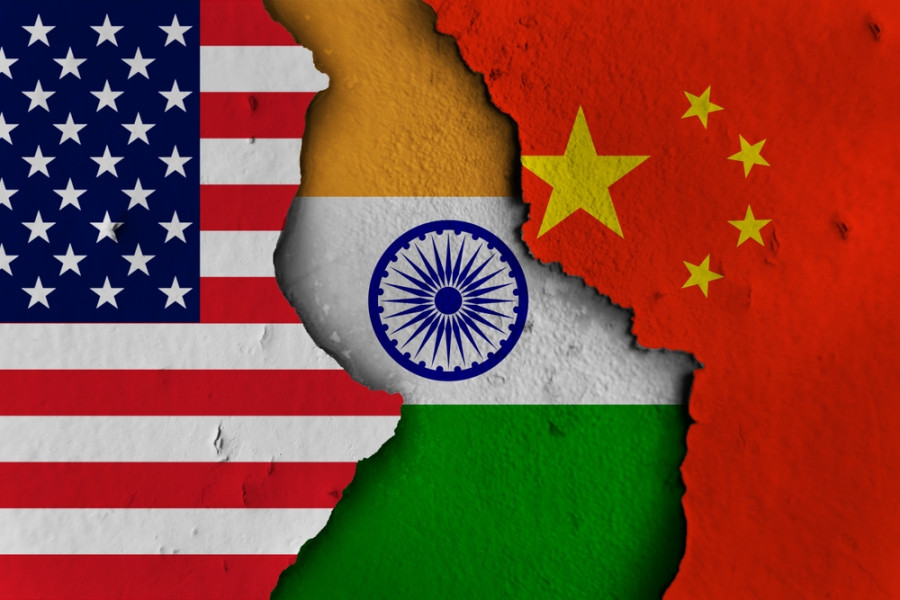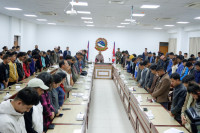Columns
Thrive in the middle
India must hew the middle ground between China and the US for its benefit.
Sunil Sharan
When two elephants clash, the grass beneath them gets crushed. The United States and China are levying ever-escalating tit-for-tat tariffs on each other. President Donald Trump of the US is getting more and more aggressive vis-à-vis China, and China is responding with its “never yield” policy. Who knows what this spat will yield? What’s in it for India? Boxed into a corner, China is sidling up to India.
Trump had imposed 26 percent of reciprocal tariffs on India this month, but has now waived them off for 90 days. When the tariffs came into effect, the Indian government said nothing, but the day they were waived, Commerce Minister Piyush Goyal and External Affairs Minister S Jaishankar said that India will not negotiate under gunpoint. China, on the other hand, had no such qualms. It levied retaliatory tariffs on the US almost immediately. President Xi Jinping of China has just visited South East Asian countries like Vietnam and Indonesia to rustle up support and to whip up anti-American sentiment. Who knows if he’ll succeed? India exports $85 billion of goods to the US. Further, India exports $110 billion of software services exports to the US, accounting for 54 percent of India’s total software services exports. US exports to India are valued at a mere $42 billion, making the trade surplus heavily in favour of India. India however faces a trade deficit of $100 billion with China. Who should India side with then?
Based on the trade numbers, the obvious choice is the US. But India is now in a position of having the cake and eating it too. India was one of the founding members of the Non Aligned Movement. Over time, the NAM became an extension of the Warsaw Pact. Indira Gandhi, as host of the 1983 NAM summit in Delhi, fervently welcomed Fidel Castro of Cuba, a staunch anti-American. During the Cold War, India was much closer to the Soviet Union than it was to the United States. With the demise of the Soviet Union, the world became unipolar and India was left with no choice but to deal with the US. Then China ascended to superpower status, but China has never been our friend. Our friendship with the US remained on-again, off-again, driven primarily by the migration of Indian people to the US in large numbers.
Came the Russo-Ukrainian war. Our all-weather friend, Russia, was battling Ukraine, a virtual non-entity to us. Russia was the mortal enemy of the West. The West took it upon itself to stop Russia in its tracks. Russia offered cheap oil to India, which we heartily availed of. In effect, we were subsidising the Russian war effort. We maintained a sheen of neutrality between Russia and Ukraine, claiming that we were on the side of peace. President Zelenskyy of Ukraine talked to us but never trusted us. Then Trump arrived and installed himself as the head honcho to broker peace between Russia and Ukraine. It remained another matter that he too ardently took the side of Russia, much to Zelenskyy’s disappointment.
Trump was re-elected on the twin planks of immigration and the economy, and he has moved with lightning speed to tackle those fronts. His immigration policies remain wildly popular with his MAGA base, but the base doesn’t seem to understand the tariff issue very much. Someone has convinced Trump that levying tariffs on the world is the way to go to restore manufacturing in his country. Trump refuses to believe that manufacturing has left his shores forever. China, as the factory floor of the world, and indeed of the US, had tied its prosperity to exports to the US. Those exports will come to a standstill with Trump’s trade war. As Fareed Zakaria of CNN recently elucidated, China now has become free to take over Taiwan. Earlier its economic prosperity tied to the US had served as a restraint for it. What will happen if China invades Taiwan?
Joe Biden seemed to have been committed to the security of Taiwan, promising boots on the ground there, but it seems that apart from making noise, Trump may do nothing. An aggressive China will send alarm bells ringing around the world, including in India. India has a golden opportunity to tread the middle ground in Trump’s trade war and play cards to its advantage. It can negotiate with China to reduce its own trade deficit. With Trump, it might have to give more than it takes, but as things stand, it is taking more than it is giving. Trump believes in a personalised style of diplomacy. If he likes a leader of the world, be it Vladimir Putin of Russia or Nayib Bukele of El Salvador, he will go to any length to appease them.
He has taken a shine to Modi. India must cash in. India today is not strong enough to become a pole by itself in the world, but it is big enough not to follow any camp. Let the Sino-US dispute go to war. Both countries will come out of it badly bruised. We must follow the middle path and come out of it smelling like roses, only to take our rightful place in the new world order that will emerge.
- The Statesman (India)/ANN




 16.12°C Kathmandu
16.12°C Kathmandu















